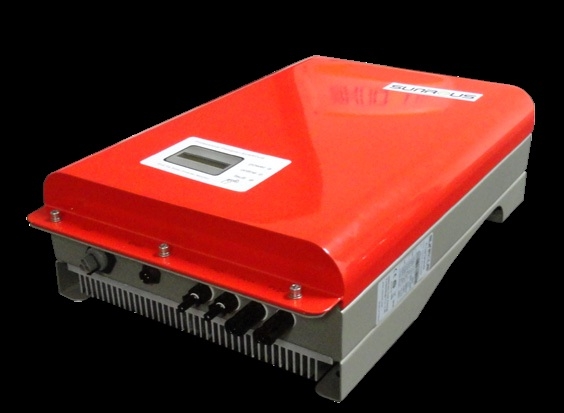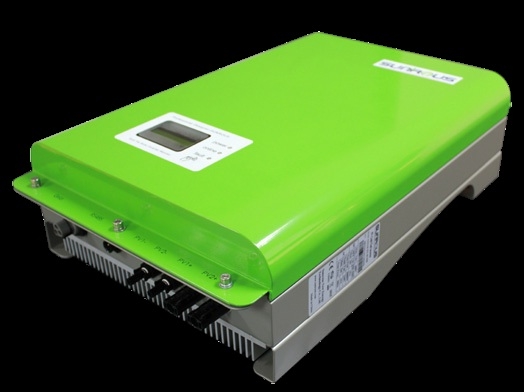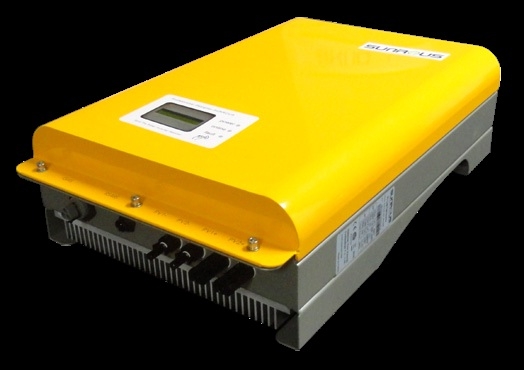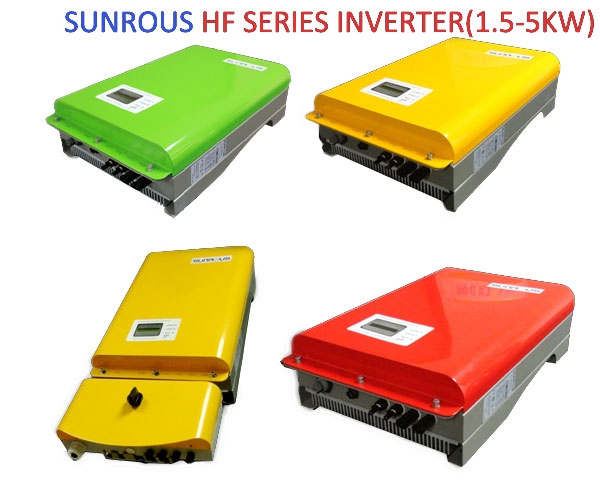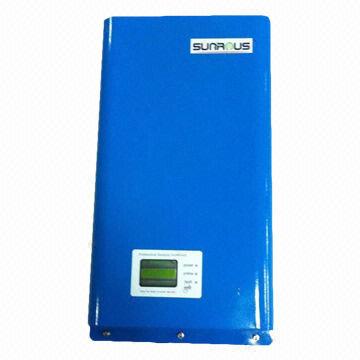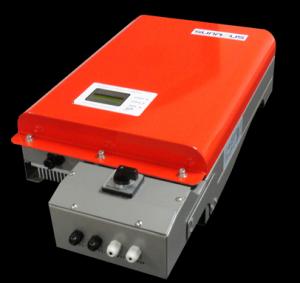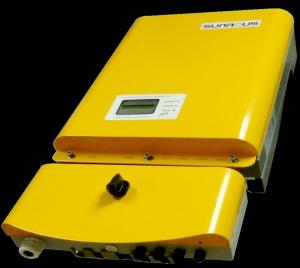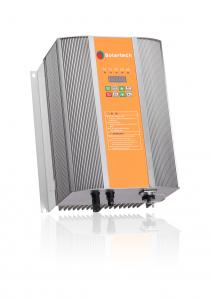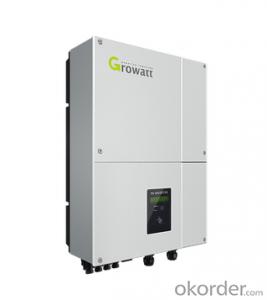Solar Inverter Kenya - High Frequency Transformer Isolation PV Grid-Tied Inverter 1.5kW - 5.0kW
- Loading Port:
- Shanghai
- Payment Terms:
- TT or LC
- Min Order Qty:
- 50 cm
- Supply Capability:
- 1000 cm/month
OKorder Service Pledge
OKorder Financial Service
You Might Also Like
· 5 years warranty
· Sealing stainless steel shell, suitable for indoor or outdoor installation
· High frequency transformer isolation
· The highest effciency achieves 98%
· Wide input Voltage range
· Adopt connectors type cable connection, Easy operation and installation
· Best tracking effciency with OptiTrac MPP control
· operating temperature range -25 ℃ to + 55℃
· High reliability due to complete protection function
· Anti-theft protection
· Plug-in grounding
HF series 1.5kw — 5.0kw
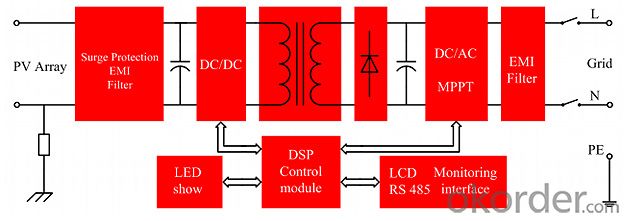
GT1.5-ZX-01/HF | GT2.0-ZX-01/HF | GT2.5-ZX-01/HF | GT3.0-ZX-01/HF | GT4.0-ZX-01/HF | GT5.0-ZX-01/HF | |
Input(DC) | ||||||
Max.DC Power | 1600W | 2100W | 2650W | 3150W | 4200W | 5200W |
Max.DC Voltage | 600V | |||||
PV Voltage range, MPPT | 150V ~ 550V | 150V ~ 550V | ||||
Max.input current | 10.0A | 14.0A | 16.0A | 20.0A | 25.0A | 30.0A |
Number of MPP trackers | 1 | |||||
Max.number of strings (parallel) | 1 | 1 | 2 | 2 | 3 | 3 |
Output(AC) | ||||||
Nominal AC power / | 1500W | 2000W | 2500W | 3000W | 4000W | 5000W |
Max.output current | 13.0A/7.0A | 17.0A/9.0A | 21.0A/12.0A | 25.0A/14.0A | 21.0A | 30.0A |
Nominal AC Voltage / range | 102-138Vac/180-264Vac | 180-270Vac | ||||
AC grid frequency / range | 47.5-51.5Hz / 59.3-60.5Hz | |||||
Power factor at rated power | 1 | |||||
THD | < 3% | |||||
AC connection | Single-phase | |||||
Efficiency | ||||||
Max. efficiency/Californian efficiency | > 98.0% / > 97.0% | |||||
MPP adaptation efficiency | > 99.0% | |||||
Protection devices | ||||||
DC reverse polarity protection | √ | |||||
AC short-circuit protection | √ | |||||
Ground fault monitoring | √ | |||||
Grid monitoring | √ | |||||
Output Transient Voltage Suppression | √ | |||||
Over load | √ | |||||
Anti-islanding | √ | |||||
General data | ||||||
Dimensions (W/ H / D) in mm | 350 / 560 / 160 | 370 / 540 / 185 | ||||
Weight(Kg) | 16 | 19 | 23 | |||
Operating temperature range | -25 ~ +60℃ | |||||
Storage temperature range | -40 ~ +70℃ | |||||
Ambient humidity | 0 ~ 100% | |||||
Consumption (night) | < 0.5W | |||||
Topology | HF-transformer galvanic isolation | |||||
Cooling concept | Convection | |||||
Enclosure type | IP65 / NEMA 3R | |||||
Features | ||||||
DC connection: PV special connector | √ | |||||
AC connection: connector | √ | |||||
LCD display & Backlit | √ | |||||
LED display | √ | |||||
Interfaces: RS485 | √ | |||||
Warranty: 10 years | √ | |||||
Certificates & approvals | G83 / G59 / TUV / SAA / ETL / JET/ CE | |||||
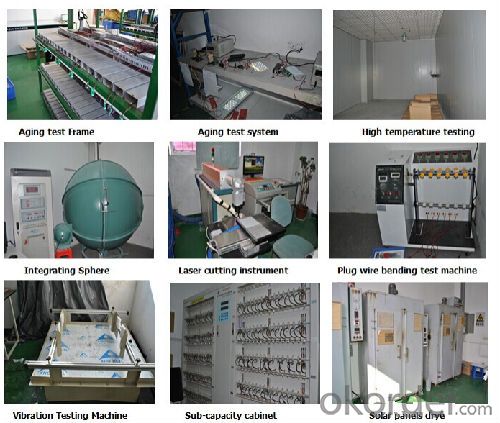
After-sales Services Undertakings
1. During the equipment commissioning period, the company will send scheduler to commissioning to ensure debugging smoothly and a one-time test commissioning.
2. The company is responsible for professional users’ on-site operator training and technical exchange.
3. The long-term tracking service system: we practice lifelong quality of our product tracking service, and we also will take effective measures and solutions for the user of the technical issues and equipment problems.
4. Regularly listen to opinions and suggestions of users, to provide users with new trends in technological innovation, new product information and enhance mutual understanding.
5. Any problems, the company will provide solutions for users within 48 hours.
FAQ
1. How do I decide which system is right for me ?
For protection from long outages, include a generator or solar panels in your Must solar system. Shorter outages can be handled by a battery-only system.
2. Where my system will be installed ?
Must solar systems are usually wall-mounted near a home's main electrical (circuit breaker) panel.
3. How do I install my system ?
A solar backup inverter is connected to a home electric system , we will supply detailed installation manual and videos for our customers .
- Q: What is the maximum power rating of a solar inverter?
- The maximum power rating of a solar inverter can vary depending on the specific model and manufacturer. However, typical residential solar inverters have power ratings ranging from 1,000 to 10,000 watts, while commercial and utility-scale inverters can have ratings exceeding several hundred kilowatts or even megawatts.
- Q: Can a solar inverter be used with different brands of solar panels?
- Yes, a solar inverter can generally be used with different brands of solar panels as long as they have compatible specifications and operating voltages. However, it is important to consult the manufacturer's guidelines or seek professional advice to ensure compatibility and optimal performance.
- Q: Can a solar inverter be used in areas with high altitude and low temperature conditions?
- Areas with high altitude and low temperature conditions can indeed use a solar inverter. However, it is important to take certain factors into account when choosing one for such conditions. The efficiency of a solar inverter can be affected by high altitude, as the reduced air density and oxygen levels can lead to a decrease in power output from the solar panels. Therefore, it is vital to select an inverter that is specifically designed to function at high altitudes. These inverters come equipped with features like advanced cooling systems and improved power electronics to ensure optimal performance in such environments. Similarly, low temperature conditions can also impact the efficiency of a solar inverter. Cold temperatures can negatively affect the internal components of the inverter and overall performance. To overcome this challenge, it is recommended to choose an inverter that is designed to operate in low-temperature environments. These inverters typically include features such as internal heaters and temperature sensors to maintain optimal performance even in freezing temperatures. Furthermore, it is advisable to seek guidance from a professional solar installer or manufacturer who can assist in selecting the most suitable solar inverter for high altitude and low-temperature conditions. They can consider factors like local climate, altitude, and specific installation requirements to ensure that the system is designed to withstand and perform optimally in these demanding conditions.
- Q: What is the role of frequency support in a solar inverter?
- The role of frequency support in a solar inverter is to ensure that the output frequency of the inverter aligns with the grid frequency. It helps in maintaining grid stability by continuously monitoring the grid frequency and adjusting the solar inverter's output accordingly. This support is crucial in preventing frequency deviations and potential disruptions to the grid, ensuring proper integration of solar energy into the electrical system.
- Q: Can a solar inverter be used with solar-powered emergency backup systems?
- Yes, a solar inverter can be used with solar-powered emergency backup systems. The solar inverter converts the direct current (DC) generated by the solar panels into alternating current (AC), which can be used to power various appliances and equipment during emergencies. This allows for the efficient utilization of solar energy stored in batteries to provide backup power when the grid is down.
- Q: Can a solar inverter be connected to a generator?
- Yes, a solar inverter can be connected to a generator. This allows the solar energy system to work in conjunction with the generator, providing additional power when the solar energy is insufficient or unavailable. The generator serves as a backup power source, ensuring a continuous supply of electricity.
- Q: Can a solar inverter be used in remote locations?
- Yes, solar inverters can be used in remote locations. They are designed to convert the direct current (DC) power generated by solar panels into usable alternating current (AC) power, which can be used to power electrical devices. Solar inverters can be installed in remote areas where there is no access to the main power grid, allowing for the generation and utilization of electricity in off-grid locations.
- Q: How does a solar inverter synchronize with the electrical grid?
- A solar inverter synchronizes with the electrical grid through a process called grid synchronization. This involves the inverter constantly monitoring the voltage and frequency of the grid and adjusting its own output accordingly to match the grid's parameters. Once the inverter's output matches the grid's voltage and frequency, it can seamlessly feed the solar-generated electricity into the grid, ensuring safe and efficient integration of solar power into the existing electrical infrastructure.
- Q: Can a solar inverter be installed indoors?
- Yes, a solar inverter can be installed indoors.
- Q: How does a solar inverter affect the overall system reliability?
- A solar inverter plays a crucial role in the overall system reliability of a solar power system. It converts the direct current (DC) generated by solar panels into alternating current (AC) that can be used to power homes or be fed back into the grid. By ensuring efficient and reliable conversion, a solar inverter helps optimize the system's performance and stability. It also incorporates various protection features like over-voltage and over-current protection to safeguard the system from potential damage. Therefore, a high-quality and well-maintained solar inverter positively impacts the overall reliability of the solar power system.
Send your message to us
Solar Inverter Kenya - High Frequency Transformer Isolation PV Grid-Tied Inverter 1.5kW - 5.0kW
- Loading Port:
- Shanghai
- Payment Terms:
- TT or LC
- Min Order Qty:
- 50 cm
- Supply Capability:
- 1000 cm/month
OKorder Service Pledge
OKorder Financial Service
Similar products
Hot products
Hot Searches
Related keywords





